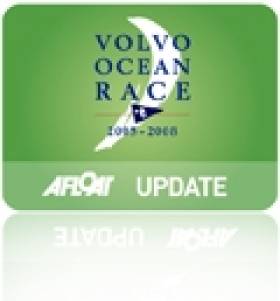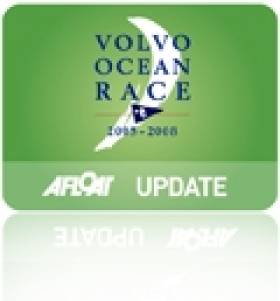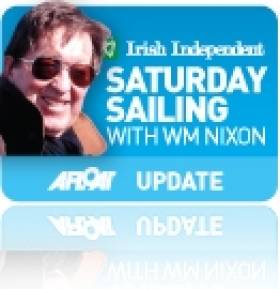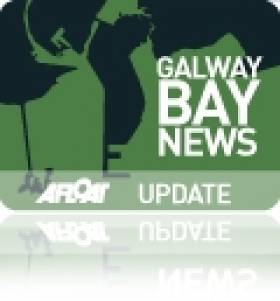Displaying items by tag: Galway Volvo Ocean Race
#vor – Thousands of people are expected to throng Salthill and the Galway coastline tomorrow (Saturday, July 7th) to watch some of the world's fastest and most spectacular sailing boats in action on Galway Bay – just 600 metres from the shore.
The final In-Port race of the 2011-2012 Volvo Ocean Race series will take place on a course between Salthill and Mutton Island and will according to Harbour Master Captain Brian Sheridan provide "an
unrivalled opportunity to see the boats being sailed hard at extremely close quarters"
The "Discover Ireland" sponsored race will get under way at 1pm and will last just under an hour.
The start line will be just 900 metres off Salthill close to Palmer's Rock and the boats will get even closer to the shore when they round a race mark just 600 meters south of Mutton Island.
Galway Harbour Master Capt Brian Sheridan says "The view of the boats from Grattan Road all the way through to Salthill will be spectacular"
After the Volvo fleet returns to Galway Harbour, accompanied by a Parade of Sail, the festival atmosphere will continue in Salthill with an Aer Corp air display and an Irish Coastguard/ RNLI air-sea rescue demonstration at about 3pm.
The Aer Corp display will involve formation and solo flights by four Pilatus PC-9M aircraft and an Augusta Westland AW 139 helicopter which will also take part in a winching operation in conjunction with the naval vessel L.E. Niamh.
A coastguard helicopter will stage another simulated rescue and winching operation in conjunction with the RNLI.
Back in the Race Village in the Harbour huge crowds are also expected to attend the overall prize giving ceremony for the 2011-2012 Volvo Ocean Race on the Main Stage at 6pm.
And the night will be rounded off by one of the highlights of the hugely successful series of free open air concerts when Sharon Shannon and her 42 piece orchestra take to the stage.
‘Nationwide’ Sets Sail for the Galway Volvo Ocean Race
#VOR ON NATIONWIDE – In addition to coverage of the Volvo Ocean Race on TG4 as previously reported, the prestigious global yachting event will also feature in tomorrow's edition of Nationwide on RTE 1 at 7 p.m.
Tens of thousands of visitors will travel to the City of the Tribes to welcome the Volvo Open 70 boats the formula one cars of the ocean and enjoy the festivities.
Nationwide meets the people responsible for bringing the event to Galway for the second time and how the people of Galway have come together to make this spectacular a reality. The programme will also take a closer look at the iconic Galway hooker boats.
#vor – Kerry's Damian Foxall Groupama team won the 11th edition of the Volvo Ocean Race early this morning when they crossed the finish line in the pitch black Galway night to settle the closest contest in the race's 39-year history.
While CAMPER were celebrating victory in the ninth and final leg, Groupama skipper Franck Cammas led his team home in second place to take an unassailable 24-point lead with just one in-port race to go.
The win for Groupama would be the first Volvo Ocean Race victory for Foxall, who has sailed round the world nine times. The Kerry man hails from Derrynane and had a childhood dream of competing in the then Whitbread Round the World Race.
Foxall is not the first Irish winner, Foxall joins hid former Green Dragon team mater Cork sailor Justin Slattery who was a winner of this race in 2006.
This morning Groupama crossed the finish line at 00:49:11 UTC, just seven minutes behind CAMPER. PUMA finished in third place at 00:55:01 UTC ahead of Team Telefonica, who finished at 00:59:33 UTC.
Cammas, the 39-year-old Frenchman, threw his arms up and pumped his fists in the air while thousands of fans gathered on the dock of Galway Bay to roar the team -- including Irishman Damian Foxall -- home to a remarkable victory in their first appearance in the race.
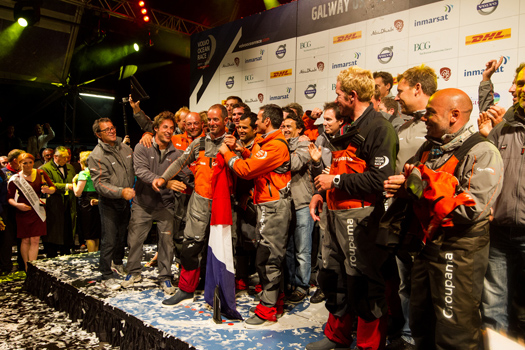
Damian is centre stage for this morning's celebrations
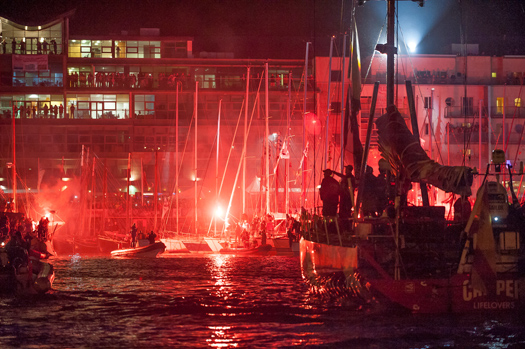
Turning the Galway night sky red. CAMPER with Emirates Team New Zealand, skippered by Chris Nicholson from Australia, arrive to a huge spectator crowd, after winning leg 9 to Galway. Photo: Paul Todd
Groupama are the first team to represent France in the Volvo Ocean Race since Eric Tabarly's La Poste in 1993-94 and they are only the second French winners after Lionel Pean on L'Espirit d'Equipe in 1985-86.
The team gallantly fought back from a deficit that was as high as 28 points following the HaiTang Bay In-Port Race in Sanya, winning the next leg to Auckland and steadily improving their knowledge of their boat and cohesion as a team to surge to a commanding lead going into Leg 9.
With the sort of nerve that quickly became their trademark in the race, Groupama stayed serenely out of trouble on the 550-nautical mile race through wild conditions in the English Channel and around the iconic Fastnet Rock, to finish second across the line and seal their place among an elite band of winners in an event that began life as the Whitbread Round the World Race in 1973.
CAMPER with Emirates Team New Zealand led the procession across the finish line much to the delight of surrounding flotilla of spectators, at 00:42:13 UTC -- their first leg win of the race.
CAMPER are almost certain to secure second place with 226 points, six points clear of third place PUMA, with just the final in-port race remaining.
Six points will be up for grabs for first place, five for second, four for third and so on when the final race of the epic 39,000 nautical mile ocean race starts on July 7.
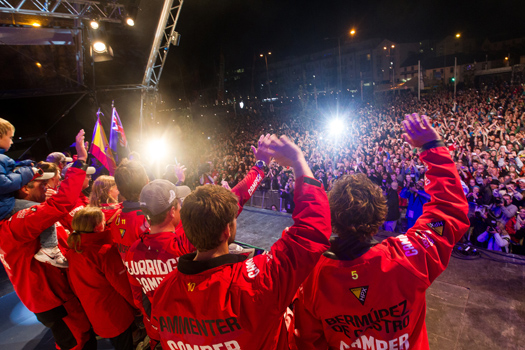
Camper are greeted by a huge crowd this morning
Standings after the final offshore leg:
1. Groupama (France) 250 points
2. Camper/ETNZ (Spain/New Zealand) 226
3. Pima (U.S.) 220
4. Telefonica (Spain) 209
5. Abu Dhabi (UAE) 124 + 5 or 10
6. Sanya (China) 40 + 5 or 10
The Minister for the Marine Simon Coveney, TD, is travelling to Galway tonight to take to the sea to welcome the Volvo Ocean Fleet at the end of its 39,000 mile round the world race.
The Minister will board a rigid inflatable boat (RIB) and make his way from Galway harbour to an area in the bay where the boats are expected between 1am and 2am tomorrow morning. They are due to enter the Harbour to a massive welcome at about 2.15 pm.
Minister Coveney will formally welcome the skippers and crew and congratulate them on their outstanding achievement.
John Killeen President of Let's do it Global, organizers of the 9 day festival built around the Volvo Race finale said, "we are delighted that the Minister, a distinguished sailor, is coming here and getting out on the bay to welcome the boats and their crews"
Sorry Mate, You're History
#VOR It's a cruel world. The Volvo 70 racers arrive in to Galway next week, and it's their last hurrah. A week today, around lunchtime, they'll become utterly obsolete after their final race of the current series, an in-port event off the City of the Tribes.
With that little sprint concluded, and the overall winners honoured in gala style, we'll all then be expected to hail the concept of the new Volvo 65s, a fleet of one designs which will start hitting the water a year hence, with a new boat being launched every seven weeks until there are eight of them, ready to roll in the Volvo Ocean Race 2014.
The idea is that it will bring costs within manageable limits. Or at least the limits can be more clearly defined. But they'll still be fairly crazy by everyday standards, even if not remotely comparable with the moolah required to keep a Formula 1 campaign on the road, or transfer your average footballer.
For wannabee contenders, it's welcome news. But for those who see the Volvo races as being the cutting edge of boat design development, it has to be a retrograde step, as having a box design (albeit within fairly severely restrained limits) did push the concepts down the road from fantasy to actuality, whereas one design should in theory make everyone equal, if unexcitingly the same.
Meanwhile, with questions being asked about just how Galway and Ireland will recoup the costs being incurred for the current jamboree, it arouses mixed feelings to learn that the financial challenge will be manageable in the future. We've enough financial challenges to deal with right now, thank you very much, before we can get worked up about getting more bang for our bucks going forward.
But we have to applaud the chutzpah of the international marine industry around the Solent area in the south of England for this turn of events. The new boats will all be built by Greene Marine of Lymington and Southampton. And we can be fairly sure that many key personnel involved, whether afloat or ashore, will be Solent-based, even if they originated from every corner of the planet.
Ironically (that's the politest word we can use of this situation), the Brits themselves don't have a boat in the current race. In fact, they haven't been seriously involved at national entry level for a long time. But their advanced marine industry has done very nicely, thank you, out of the Volvo Race over the years.
Here in Ireland, however, the supporters will have to do an awful lot of partying down Corrib way simply to keep the Irish Volvo Race show on the road. Happily, recent experience gained by fans in Poland, the Ukraine, and New Zealand will be invaluable.
With the final results being totted this weekend for the Round Ireland Race from Wicklow, the predictions here last weekend that Piet Vroon's Ker 46 Tonnere de Breskens or French skipper Laurent Gouy's Ker 39 Inismor (of Clifden, among other places) proved to be spot on.
Aspiring offshore racers would do well to study everything about the Tonnere and Inismor campaigns. In a race which eventually comes down to making fewer mistakes than anyone else, they seldom put a foot wrong. Sailing at this level is a pleasure to watch. But with the Irish weather in a cussed mood and fog plaguing much of our coastline, very few saw Tonnere de Breskens and Inismor going so beautifully and purposefully about their business.
W M Nixon's sailing column is in the Irish Independent on Saturdays
Historic Cargo Delivered for Galway’s Grand Finale
#VESSEL VOLVO VILLAGE – Following yesterday's historic arrival of the Deo Volente, the first container ship to be unloaded in Galway Harbour which took six hours to complete concluded the delivery of logistics for the Volvo Ocean Race Grand Finale, writes Jehan Ashmore.
The cargo of containers packed with the spectator stand for the prestigious events 'Pop-Up' Village had travelled from Lisbon. But before any of this could be done the heavy-lift cargoship had to enter through the Galway's port dock gates. This was followed with the vessel making manoeuvres in the confines of the tidal basin of Dun Aengus Dock. It was a tight squeeze as the 105m long vessel edged closer to the berth in the basin which was witnessed by onlookers lining the quays.
The vessels cargo was almost the entire race village which is a travelling show that traverses the globe as part of the Volvo Ocean Race 2011-2012. It provided a "new challenge for Galway Harbour in handling containers" said Harbour Master Captain Brian Sheridan and I am delighted that the operation went better than anticipated.
After overnighting in the port, Deo Volente sailed this morning en-route to Rotterdam to pick up a cargo bound for the St. Lawrence Seaway. Currently the vessel is underway off the south-west coast.




























